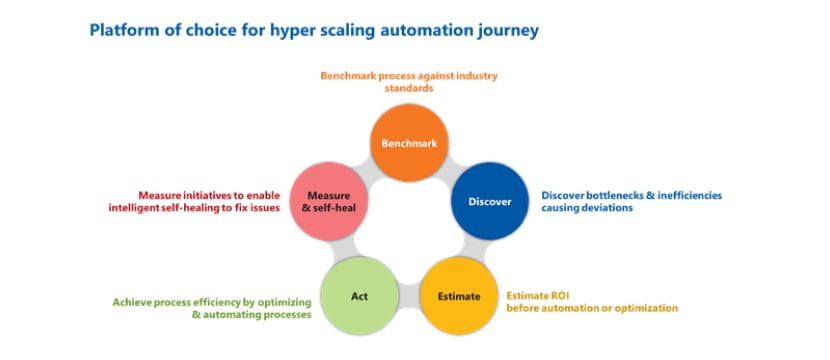

Summary
Even though more and more enterprises are adopting robotic process automation, a large percentage of projects don’t deliver on the expectations. The reasons for failure range from lack of focus to visibility. In this article, I will take you through 10 ways you can guarantee Automation success.
As a critical business imperative, RPA continues to be a crucial driver of enterprise digital transformation. Gartner predicts1 a market cap of $1.89 billion for RPA software revenue in 2021, up 19.5% from last year, and forecasts such double-digit growth for the next three years. The impact of COVID-19 exacerbated an already critical need for digital transformation, and automation is essential to power this process, offering increased efficiencies, accuracy, cost reduction, and adding resilience. That’s why it is no surprise that the report also suggests 90% of large enterprises across the world will adopt RPA in some capacity by next year and triple their RPA portfolio capacity in the next three years.
A substantial improvement in enterprise productivity and quality is the most significant benefit of the adoption of Intelligent Automation. Enterprises today realize that efficiency and accuracy at scale are prerequisites to thrive in a competitive environment marked by uncertainty and volatility. They also understand the need to invest in technologies capable of driving fundamental long-term impact with few incremental investments. For these reasons, RPA is a business necessity, and enterprises are looking to implement automation at scale. However, while these benefits present a robust case for automation implementation, there are also challenges.

How Human Bias Hinders Automation Performance
Enterprises building their RPA ecosystem complete the following steps usually:
-
Mine ideas for automation from employees
-
Validate these ideas before listing potential automation candidates
-
Prioritize automation opportunities
-
Develop and automate
-
Measure RoI
During development, developers create requirements and design automation in consultation with SMEs before using RPA studios to configure the final automation. In theory, the process works well and has enough checks and balances to drive improvements over the status quo.
Why then, as EY suggests based on their experience, do almost 30 to 50% of early RPA projects fail?2 The EY report details a range of reasons, including:
-
Seeing RPA as IT-led instead of business-led
-
Delaying planning until after pilots
-
Automating the wrong processes
-
Viewing RPA as a one-off automation exercise instead of a comprehensive transformation program
Over the past few years, new and existing tools and frameworks such as process mining and process discovery have injected empirical validation into every step of the enterprise automation journey. However, while implementations today benefit from data-validated decision-making, planning doesn’t. Virtually every step in the planning process ideation, prioritization, and briefing happens manually and without empirical data. When you combine this problem with frequently shallow inputs based on anecdotal evidence and the manual interviews that influence the ultimate design, it is easy to see that the current RPA implementation process is fraught with manual bias from the collection of ideas through to automation.
The result?
-
Reduced business trust in automation projects
-
A lack of a scientific approach that can forecast, validate, and assure automation success
-
An inability to measure and validate RoI, further limiting both spends and planning effort
-
The absence of clarity and objectivity in a decision-making process riddled with human bias
-
Shallow inputs that limit the specificity of implementation and affect the output
-
No empirical way to prioritize automation use cases
Our experience has shown that RPA is at its most successful when adopted as an enterprise-wide transformation program. This adoption needs trust, and it requires clarity, which is precisely what a more empirical, data-driven approach offers. Granular empirical data combined with intelligence and analytics increased the effectiveness of RPA implementations exponentially, and an RPA-driven approach from the outset could do the same for planning. RPA could drive better RPA.
Connected Automation – The Future of Automation Programs
There is an obvious case to consider a new data-driven view of automation planning and implementation. What if, right from the start of the planning process, we could combine the efficiency of automation with the instinct of human intuition to create an empirically sound automation plan? The impact of data would eliminate bias, increase accuracy, and offer the measurability and insights to drive leadership support and success at scale. In addition, it will lead to a mechanism of continuous learning and validation of decisions at each stage of the implementation.

Understanding the Insight-driven Automation Journey
Each of the five stages in the framework above comprises specific steps for substantiation and validating, driving greater confidence, accountability, accuracy, measurement, and troubleshooting. Let’s look at this insight-driven automation journey:
-
-
Benchmark your tasks and processes against standards
-
Before making an automation decision, it’s important for businesses to make an on-ground assessment of where their tasks and processes stand. Benchmarking your tasks/processes against industry and functional standards is the right first step in this direction. That’s why the first step is to benchmark tasks and processes to industry standards and function standards. Next, enterprises can compare their task and process performance with either their industry or function (Procurement, HR, Finance, etc.) by using detailed process maps. This benchmarking exercise allows business leaders to assess the need for RPA and outline base objectives to gauge what they need to achieve from their implementation.
-
-
Collaboration Hub for automation ideas
-
Another essential step in the planning process is the aggregation of ideas. Great ideas can come from anywhere, but the best ones come validated. A structured, automated, and intelligent centralized repository will gather ideas from across the organization. It will then validate them using benchmarking data, driving a scientific process to measure idea quality, a far cry from the usual method of picking contenders from unwieldy email threads. Once the benchmarking is complete and ideas shortlisted, enterprises can move to the next stage, where they discover process automation candidates and build their automation blueprint.
-
-
Process discovery through on-ground task maps
-
Even though ideas are validated superficially, the detailed discovery of these ideas is crucial. In line with current best practices, enterprises should take on a comprehensive process discovery exercise based on empirical data gathered from user keystrokes to identify automation candidates. Then, using on-ground task maps built with primary data, process leaders can make informed decisions, driving better implementation success and increased business resilience through awareness of exceptions from the outset.
-
-
Granular step-level insights and automation opportunities
-
This step highlights specific areas within the identified task where opportunities to improve and automate are present. With granular step-level insights, specific parts or variations of the tasks that can be automated are identified
-
-
Prioritization of automation opportunities (Automation Blueprint)
-
The current prioritization process is completely manual, depending on anecdotal data on the human effort and potential of savings. Today, however, leading discovery tools can use empirical data and advanced algorithms to create simple 2X2 matrices to prioritize automation use cases. This unprecedented clarity ensures greater confidence in execution planning and offers a clear direction for RPA implementation.
-
-
Estimate RoI to build a data-driven business case
-
Any technology intervention must improve topline and bottom-line revenues, which makes it surprising that current business cases for RPA remain focused on experimentation or expectations based on industry standards. Since this framework uses both primary data from the enterprise and secondary data featuring industry benchmarks, it is now possible to estimate the RoI of RPA implementation and build a robust data-driven business case, eliminating subjectivity and increasing leadership confidence in the exercise.
-
-
Shortened requirements gathering process and one-click task map export to RPA studio
-
A manual briefing process has significant issues. On the one hand, it needs SMEs to spend hours explaining the process to developers, and, on the other, it frequently misses exceptions, focusing on the aspects that work instead. The outcome is a time-consuming exercise resulting in significant failures as the bots are not configured to handle exceptions. In the insight-driven automation journey, however, SMEs have access to task maps to see all process variations and make a conscious decision about the aspects to automate. They can then choose the suitable variation to automate and export it to an RPA studio with a single click.
For developers, this tool automatically creates a detailed requirements document complete with a pre-configured task map. In addition, the conversation with an SME is more focused, designed to solve queries instead of providing a thorough understanding. The briefing process is now free from human bias in this framework, ensuring higher clarity, greater efficiency, lesser subjectivity, and substantially better performance.
-
-
RPA execution in action
-
Automation configuration, the final execution step, is much simpler through this framework. Previously, developers would need to build automations from scratch with a plan based on incomplete and often inaccurate information. Since developers already have a partially configured process map, detailed and validated, they only need to make minor corrections and additions to complete the configuration.
-
-
RPA RoI Analytics and Insights
-
Once the implementation is complete, it is helpful for enterprises to match estimated RoI to actual RoI to assess the success of the execution. Here, automation analytics focused on RoI can be invaluable. With comprehensive automation analytics, business leaders can compare estimated RoI to actual RoI and compare automation RoI to the pre-automation numbers on customized analytics screens. In addition, if they find that the actual RoI is lower than expected, they can also drill down further by understanding possible reasons, including bot failure rate, exception management issues, or any other performance concerns.
-
-
Continuous Monitoring and Improvement (Self-heal)
-
The next level in this journey is to figure out issues automatically and enable a thorough analysis before identifying and implementing fixes automatically. Automatic troubleshooting, analysis, and fixing create a self-healing system capable of continuous improvement, significantly reducing both costs and effort over time. Once the system stabilizes, the process returns to the benchmarking step and begins all over again.
Driving the Future of Enterprise with Insight-Centric Automation
This fundamental change in RPA planning, driven by Self-Drive Automation, will enable enterprises to create a culture of continuous improvement, intelligence, and efficiency designed to provide resilience and improved performance. Integrating simplicity, efficiency, validation, and detailed analytics into every step of the process also transfers control of RPA-driven transformation from IT and developers to business, which is where it should always have been. Efficiency gains notwithstanding, the proposed framework also creates the critical resilience that businesses today need by establishing a collective awareness of exceptions from the outset.
Today, we can consider the possibility for automation at scale with the infusion of clarity, specificity, efficiency, and measurability. Instinct has its place, but it cannot be the fulcrum of execution. As we move into a new age for enterprise growth, powered by resilience and endurance as much as dynamism and innovation, insight-centric automation will be the bedrock of enterprise transformation.
Loved what you read?
Get 10 practical thought leadership articles on AI and Automation delivered to your inbox


Loved what you read?
Get 10 practical thought leadership articles on AI and Automation delivered to your inbox



